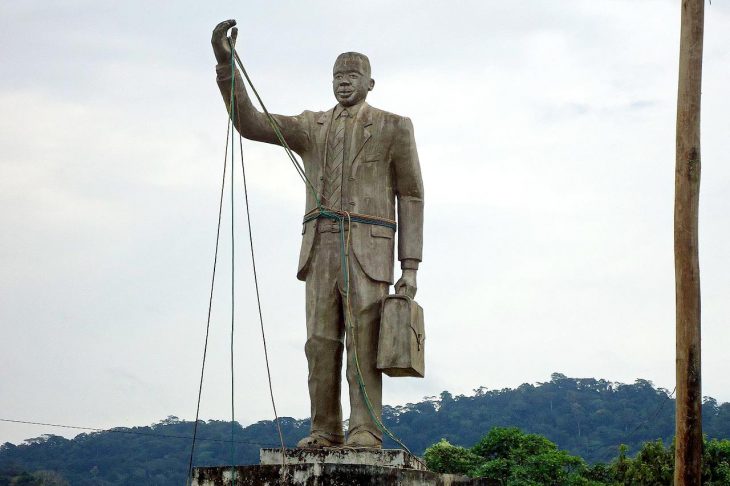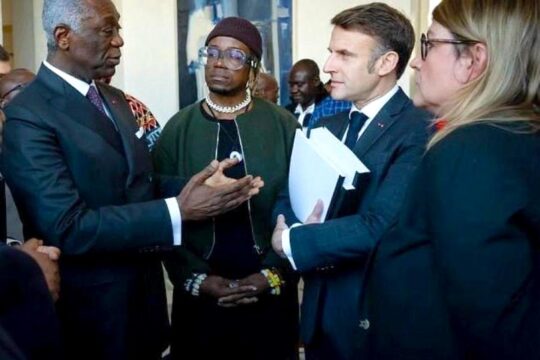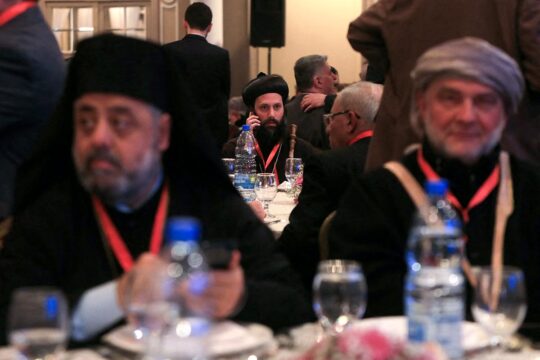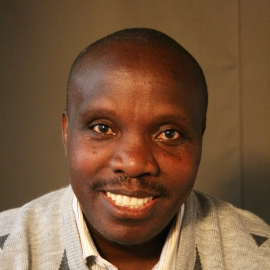"After having shot him in his forest hideout, France and its Central African henchmen also wanted to kill him in the hearts of Cameroonians. But they did not succeed," says activist André Blaise Essama of Ruben Um Nyobè. This Cameroonian independence fighter was killed precisely 63 years ago by the French army. When Essama was a child, the name of this hero was evoked in the greatest secrecy. But today, against all odds, the memory of Um Nyobè has come out of hiding -- to the great displeasure of the current regime of Paul Biya, whom Essama and other Cameroonian activists accuse of being a "servant" of France.
From farmer’s son to militant nationalist
Um Nyobè was born in 1913 in Bassa country, in the south of Cameroon, which was under German occupation at the time. His mother and father were small farmers. After the German defeat at the end of the First World War, the new League of Nations (predecessor to the United Nations) gave France and the United Kingdom a mandate to administer Cameroon. After his studies in Presbyterian schools in French Cameroon, Um Nyobè became a civil servant. He became known as a trade unionist before creating, in 1948 in Douala, the Union of the Peoples of Cameroon (UPC), a nationalist party. The UPC campaigned for the reunification of the country, independence and social justice. Very quickly, he became the undisputed leader of Cameroonian nationalism. He began to be called the Mpodol ("spokesman for his people" in the Bassa language).
"Ruben Um Nyobè has an almost mythical, extremely powerful aura. He is a key figure in the struggle for Cameroon's independence, the lynchpin, a thinker, an outstanding organizer, a unifier of absolute integrity,” explains French journalist Thomas Deltombe, co-author with Manuel Domergue and Jacob Tatsitsa of the book "Kamerun! A Hidden War at the Origins of Françafrique (1948-1971)". “He enjoys immense respect from his compatriots, and his qualities are recognized in the confidential reports of the French colonial administration and police. He is the most emblematic figure of the UPC."
In 1955, a new High Commissioner, Roland Pré, arrived in Cameroon, determined to put an end to the UPC and to Um Nyobè, whose charisma was disturbing. Barely after Pré's arrival, social unrest shook Cameroon, causing several deaths. The French government used this as a pretext to ban the UPC on July 13, 1955. Um Nyobè went into hiding in a forest in his native region. And the colonial administration swore to find and kill him. The hunt began.
Body immersed in concrete
"His hideout was spotted around September 13, 1958. During the hunt, Um Nyobè's companions were arrested. Under torture, some of them told the French army where he was. On September 13, 1958, he was shot by a unit of auxiliaries commanded by a French officer," recounts Cameroonian historian Jacob Tatsitsa in an interview with Justice Info.
In his book "La naissance du maquis dans le Sud-Cameroun," (Birth of the Resistance in southern Cameroon), Cameroonian philosopher Achille Mbembe describes this killing, which he says took place in the early morning. "The soldiers, including a Chadian conscript, Sara Abdoulaye, were firing in all directions. The trackers did not recognize Um Nyobè at first. (...) It was then that one of the guides pointed him out to the troops. Abdoulaye fired and hit him from behind. Um Nyobè collapsed, dropping a briefcase containing some documents and notebooks in which he had written down his dreams, and he died with a groan. Before being buried, his body was immersed in a concrete block. By disfiguring the corpse, they wanted to destroy the individuality of his body and reduce it to a shapeless and unrecognizable mass." The ultimate goal, Deltombe adds, was to "root out the idea of independence from the very minds of Cameroonians”.
The assassination of Um Nyobe did not, however, mean the death of the Cameroonian independence movement, even if "it dealt it a heavy blow and demobilized some of the fighters," says Tatsitsa.
Paris stooge Ahmadou Ahidjo defeats the UPC insurgents
After getting rid of the main pro-independence leader, France granted independence to Cameroon on January 1, 1960. Elections were held in May the same year, while in the Bassa and Bamileke regions the French army continued to repress UPC militants. Ahmadou Ahidjo, a protégé of Paris, took advantage of this situation and became the first president of the Republic of Cameroon following massive electoral fraud.
The UPC then launched an armed insurrection that was put down by Ahidjo with the help of French military advisors. According to the book "Kamerun! Une guerre cachée aux origines de la Françafrique", it was French officers who secretly directed the operations by the new Cameroonian army against the insurgents. A range of methods were used: torture, forced regrouping of the population, extrajudicial executions, psychological warfare and poisoning. Nationalist leaders were killed not only in Cameroon but also in exile. Returning to the country to coordinate the insurrection from within, Ernest Ouandié, a fellow fighter of Um Nyobè, was arrested in 1970, tried and sentenced to death. He was executed on January 15, 1971.
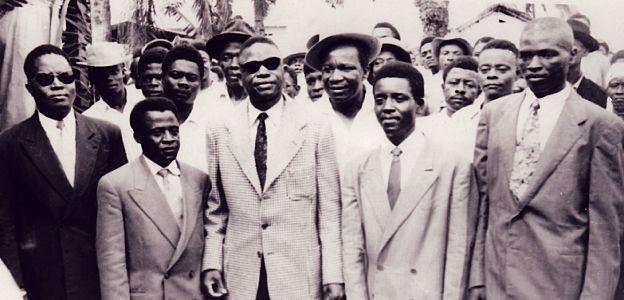
Crimes never recognized by France
Because of the strategic secrecy maintained by France around this conflict, it is difficult to give a human toll. British archives mention 76,000 deaths between 1954 and 1964. On a visit to Cameroon in 2009, François Fillon, then French Prime Minister, declared without flinching: "I absolutely deny that French forces participated in any way in the assassinations in Cameroon. All this is pure invention.”
On July 3, 2015, after a meeting with Paul Biya, in Yoaundé, the French head of state François Hollande took a first timid step, responding to the press. "On the question of history, it is true that there have been extremely tormented and even tragic episodes, since after independence there was repression in the Maritime Sanaga and in Bamileke country," he said. The word "war" was subtly avoided.
However, 63 years after Um Nyobè's assassination, the traces of this bloody repression are still visible. "I have met survivors who still suffer from pathologies linked to the torture they underwent" in the hands of the French army, says Tatsitsa. "The Bassa region is still isolated, a kind of punishment for its lack of submission to the French army.” For the Cameroonian historian, France must make reparation: "Just as the British compensated the Mau-Mau fighters (in Kenya), France should compensate the UPC fighters and make economic and cultural investments in the areas concerned, as a form of collective reparation.”
Théophile Nono, secretary general of the Mémoire 60 collective, notes, however, that there is "not yet a structured movement that demands reparations in an official way”.
Eclipsed by the Algerian war
For Deltombe, the war in Cameroon was overshadowed by "a combination of different factors. First France, to which the United Nations had granted trusteeship over Cameroon, had to conceal the massive repression because it was illegal under international law and contravened the trusteeship agreements signed with the UN in 1946”. Then there was "the fact that it coincided with the Algerian war, which monopolized the attention" of French public opinion and media. Finally, the defeat of the nationalists itself contributed to this concealment, and the authorities of independent Cameroon continued the work of annihilating the UPC, by prohibiting any reference to Um Nyobè and his companions in the struggle”.
Cameroonian Tièmeni Sigankwé, a researcher at the National Education Centre, agrees with this analysis. "This episode is little known because all those who fought for reunification and independence were eliminated or dismissed. Today, in school history curricula, little is devoted to these nationalists. At one point, it was even forbidden to talk about the UPC, and mentioning the people who fought for independence was considered a subversive act."
Under current President Biya, who has been in power since 1982, it was not until December 1991 that the first law was passed to "rehabilitate great figures of Cameroon's history who have disappeared and who have worked for the birth of national sentiment, independence or construction of the country, promotion of its history and culture”. The law mentions Ruben Um Nyobè and Ernest Ouandié... but also Ahmadou Ahidjo.
Family, friends and admirers of Um Nyobè then rushed into this breach, erecting in 2007 a monument to the memory of their hero in Eseka village in Bassa country, which was the independence leader’s native land. But, according to the Cameroonian media, the government was not represented at the inauguration on June 22, 2007, although it was duly invited. "The rehabilitation law has not been translated into reality," says Sigankwé.
Cameroonians were expecting a concrete gesture for the 50th anniversary of independence on January 1, 2010. But, as Sigankwé points out, "in his speech, President Paul Biya referred to those who fought for independence, but without mentioning a single name”.
Today, mentioning the war of independence and its heroes is no longer a subversive act. But the government has other weapons at its disposal, as Théophile Nono, secretary general of the Memory 60 collective, testifies: "Our association was created in 2010, but the administration refuses to recognize us because our objective is to promote the duty to remember the struggle for the reunification and independence of Cameroon.”
Essama’s activist crusade
Activist Essama does not need this recognition to act. For the past ten years, he has been on a crusade against the symbols of colonialism that still stand in the country, especially in Douala. "The decolonization of public spaces is an imperative, destroying the monuments of the colonists is an act of public health. To each people its heroes, to each nation its pride," he told Justice Info.
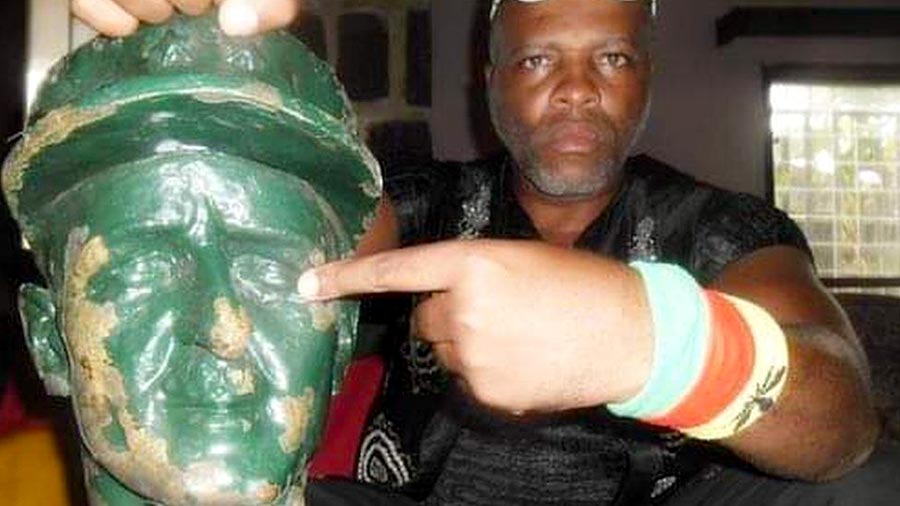
His first target was the statue of General Philippe Leclerc, considered in France to be a hero of the Second World War. Essama wanted to replace it with a monument to the memory of Um Nyobe. After toppling the statue of the French general in 2003, he decapitated it several times, for which he spent time in prison. After restoring the statue's head each time, the Douala authorities finally sealed it off and assigned guards to secure it. Essama says he has now given up attacking statues in favour of a campaign with his group, Essama Hoo Haa, for the erection of monuments to Cameroonian and African heroes.
In the streets of Douala, "the fighter", a colourful character, rides his bicycle decorated with the colours of Cameroon and with a banner on the front in memory of Um Nyobe. To commemorate the assassination of his hero, Essama has announced that his group will show a documentary this week featuring relatives of the nationalist who are still alive, including his children and two wives. "The authorities will not be able to stop our movement," he says.


